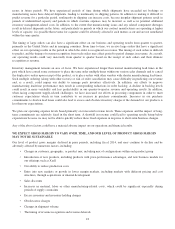Cisco 2014 Annual Report Download - page 32
Download and view the complete annual report
Please find page 32 of the 2014 Cisco annual report below. You can navigate through the pages in the report by either clicking on the pages listed below, or by using the keyword search tool below to find specific information within the annual report.OVER THE LONG TERM WE INTEND TO INVEST IN ENGINEERING, SALES, SERVICE AND MARKETING
ACTIVITIES, AND THESE INVESTMENTS MAY ACHIEVE DELAYED, OR LOWER THAN EXPECTED,
BENEFITS WHICH COULD HARM OUR OPERATING RESULTS
While we intend to focus on managing our costs and expenses, over the long term, we also intend to invest in personnel and
other resources related to our engineering, sales, service and marketing functions as we realign and dedicate resources on key
growth areas, such as data center virtualization, software, security, and cloud, and we also intend to focus on maintaining
leadership in routing, switching and services. We are likely to recognize the costs associated with these investments earlier
than some of the anticipated benefits, and the return on these investments may be lower, or may develop more slowly, than we
expect. If we do not achieve the benefits anticipated from these investments, or if the achievement of these benefits is delayed,
our operating results may be adversely affected.
OUR BUSINESS SUBSTANTIALLY DEPENDS UPON THE CONTINUED GROWTH OF THE INTERNET AND
INTERNET-BASED SYSTEMS
A substantial portion of our business and revenue depends on growth and evolution of the Internet, including the continued
development of the Internet and the anticipated transition to IoE, and on the deployment of our products by customers who
depend on such continued growth and evolution. To the extent that an economic slowdown or uncertainty and related
reduction in capital spending adversely affect spending on Internet infrastructure, including spending or investment related to
IoE, we could experience material harm to our business, operating results, and financial condition.
Because of the rapid introduction of new products and changing customer requirements related to matters such as cost-
effectiveness and security, we believe that there could be performance problems with Internet communications in the future,
which could receive a high degree of publicity and visibility. Because we are a large supplier of networking products, our
business, operating results, and financial condition may be materially adversely affected, regardless of whether or not these
problems are due to the performance of our own products. Such an event could also result in a material adverse effect on the
market price of our common stock independent of direct effects on our business.
WE HAVE MADE AND EXPECT TO CONTINUE TO MAKE ACQUISITIONS THAT COULD DISRUPT OUR
OPERATIONS AND HARM OUR OPERATING RESULTS
Our growth depends upon market growth, our ability to enhance our existing products, and our ability to introduce new
products on a timely basis. We intend to continue to address the need to develop new products and enhance existing products
through acquisitions of other companies, product lines, technologies, and personnel. Acquisitions involve numerous risks,
including the following:
• Difficulties in integrating the operations, systems, technologies, products, and personnel of the acquired companies,
particularly companies with large and widespread operations and/or complex products, such as Scientific-Atlanta,
WebEx, Starent, Tandberg and NDS Group Limited
• Diversion of management’s attention from normal daily operations of the business and the challenges of managing
larger and more widespread operations resulting from acquisitions
• Potential difficulties in completing projects associated with in-process research and development intangibles
• Difficulties in entering markets in which we have no or limited direct prior experience and where competitors in
such markets have stronger market positions
• Initial dependence on unfamiliar supply chains or relatively small supply partners
• Insufficient revenue to offset increased expenses associated with acquisitions
• The potential loss of key employees, customers, distributors, vendors and other business partners of the companies
we acquire following and continuing after announcement of acquisition plans
Acquisitions may also cause us to:
• Issue common stock that would dilute our current shareholders’ percentage ownership
• Use a substantial portion of our cash resources, or incur debt, as we did in fiscal 2006 when we issued and sold $6.5
billion in senior unsecured notes to fund our acquisition of Scientific-Atlanta
24
























